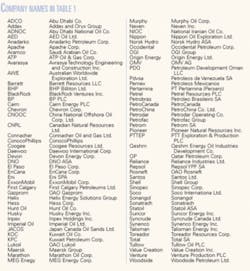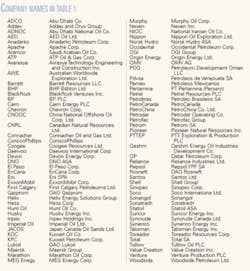Many oil and gas projects are set to come on stream in the next few years and help meet expected increases in the world’s energy demands.
Table 1 (Click here to download a PDF of Table 1) lists numerous announced major upstream projects in 50 countries, including development of individual fields and the supporting infrastructure, such as:
- Projects for developing new oil and gas discoveries. The projects listed exclude many announced discoveries that are in delineation without publicly available development plans.
- Field redevelopments for recovering bypassed oil.
- Stranded-gas projects and projects to eliminate gas flaring. These projects often include new infrastructure such as pipelines for transporting gas to end users or facilities for producing LNG and GTL.
- Heavy-oil projects that may include such new infrastructure as pipelines, crude oil upgraders, and mines.
- Deepwater projects, some of which rely on long flowline tiebacks and hubs.
- Development of unconventional resources such as tight sands, shale gas, and coalbed methane gas.
If all the projects listed had a peak production rate in the same year, the total world production capacity would increase by 30 million b/d and 78 bcfd.
Operators, peak production
Although joint ventures operate some projects listed in Table 1, for simplification, the table only includes the name of one of the companies in the joint venture (see accompanying tabulation listing the company’s parent firm’s full name).
Table 1 shows the year in which the production from a project or a phase of the project may peak or enter a peak production plateau that could last for several years. Operators plan to develop many of the larger projects in several phases, as noted in the table.
Asia-Pacific
The Asia-Pacific region has several large LNG projects proposed or under development. One main project is Greater Gorgon, which will obtain gas from several large discoveries off Australia containing more than 40 tcf. Gorgon will have two 5-million tonne/year LNG trains and a domestic gas plant on Barrow Island. The project also includes reinjection and sequestration of carbon dioxide on Barrow Island.
Final approval for the development is still pending. The project has obtained the go ahead from Western Australia’s minister for the environment but awaits federal environmental approval. Once approved, Gorgan may start shipping LNG after 2010.
The Sunrise and Troubadour field projects off East Timor and Australia are on hold awaiting ratification of treaties between the two countries. The projects would involve development of about 8 tcf of gas that an expansion of the Bayu Udan LNG plant would process.
Ichthys is a large 9.5-tcf deepwater gas and condensate project off northwest Australia that may include a semisubmersible production with a flowline to shore connected to a new LNG liquefaction plant.
In Indonesia, several new fields will supply gas to existing and new LNG plants and power stations. The largest new LNG project is Tangguh, which will come on stream in 2009 and process gas from new fields in Papua Bintuni Bay.
Indonesia also has several oil developments. Banyu Urip field in the Cepu block on Java is the largest oil field discovered in Indonesia in many years. The field will go on stream after 2010, exporting oil from a floating storage vessel moored off Tuban in the Java Sea.
Another large project in Indonesia is the planned development of 40 tcf of gas in Natuna D-Alpha field, discovered several decades ago. Development was delayed partly because of the high carbon dioxide content of the gas that complicates production facilities. ExxonMobil Corp. and the government of Indonesia are in discussions related to the terms for proceeding with the project.
India has both onshore oil and gas discoveries as well as large, deepwater 12-tcf discoveries off the country’s eastern coast. The offshore gas possibly will be produced through subsea-completed wells brought to shore with long flowlines.
Several new projects will develop additional fields off China in both the South China Sea and Bohai Bay.
The Kikeh projects off Sarawak will be Malaysia’s first deepwater project to start producing. Operator Murphy Oil Corp. expects first oil from the project in second-half 2007.
Gas production is slated to begin from an onshore field in Bangladesh and fields off Myanmar.
Development of gas fields in the Southern Highlands of Papua New Guinea has encountered some delay after plans to lay a 3,000-km pipeline to Queensland, Australia, were dropped. Development of this gas may now include construction of an LNG liquefaction plant.
Western Europe
Two large projects off Norway will go on stream this year. The subsea completed wells at Snøhvit started filling the 143-km flowline at the end of May, and LNG production will start later in the year.
Ormen Lange is the other large project that will come on stream in 2007. The produced gas, condensate, and water stream from subsea-completed wells will flow to shore through two 30 in., 120-km flowlines. First gas is expected in October 2007.
Norway also has numerous projects that will tie back subsea-completed wells to existing offshore facilities.
In Italy, the onshore Tempa Rossa project will develop an estimated 200 million bbl of heavy oil reserves.
Eastern Europe, FSU
Phased development of Tengiz field continues with the $6-billion second generation plant and sour-injection projects.Plans call for the projects starting up in 2007 and increasing crude production capacity in 2008 to 460,000-550,000 b/d from the current 300,000 b/d.
Also in Kazakhstan, the first phase of the 13-billion-bbl Kashagan field should start producing in 2010.
New pipeline projects in Russia will allow production of several of its stranded gas fields, with the 120-tcf Shtockman field in the Barents Sea being the largest. The first phase of Shtockman field may start producing gas in 2011 at a rate 2.1 bcfd. Subsequent phases may increase production to 8.7 bcfd in 2014-19.
Another large field under development is the 70-tcf Kovykta in eastern Russia. Gazprom has recently become operator of the field that will require new pipelines for moving the gas to potential users, such as in China.
Middle East
Iran has a several large projects slated for developing light to heavy oil, as well as continued phased development of the offshore South Pars gas field, an extension of Qatar’s giant North field.
Iraq has considerable potential in adding oil production capacity, although the agreements for developing its resources have not been finalized. Table 1 lists some of the potential fields that might be developed. One project that is proceeding is DNO ASA’s development of the Tawke field in the Kurdish area of Iraq near the border with Turkey.
Kuwait is continuing to redevelop several fields that will increase its production capacity by 450,000 bo/d in 2012.
In Oman, a steamflood will develop the estimated 1 billion bbl of heavy-oil resources in the Mukhaizna field.
Phased development of the 900-tcf North field off Qatar continues with additional LNG trains and a GTL plant, although ExxonMobil canceled its proposed GTL plant in the country.
Saudi Arabia expects its various projects to add more than 3 million bo/d of production capacity. Its largest development is the Khurais expansion that has a designed peak production capacity of 1.2 million bo/d.
ADCO in Abu Dhabi plans on expanding the production capacity in various fields by 560,000 b/d.
Africa
Several projects in Algeria will redevelop fields that have produced for many years including Rhounde El Baguel field, the largest oil field in Algeria, which went on stream in 1962. Sonatrach expects production from this redevelopment to peak at 100,000 bo/d in 2009.
New projects off Angola will add 1.8 million bo/d in production capacity. These projects mostly depend on floating production, storage, and offloading (FPSO) vessels and subsea wells for production.
A barge-based facility moored in deepwater off Congo (Brazzaville) will produce oil from the Moho and Bilondo field.
Gas production off Equatorial Guinea will increase after completion of an LNG liquefaction plant on Bioko Island.
An FPSO is slated to produce Olowi field in 100-m water off Gabon.
The first offshore project off Libya will transport gas to Italy.
Nigeria has several LNG projects on tap for monetizing primarily associated gas, some of which is gas that was flared. Development of deepwater resources also continues and will add about 1.4 million bo/d on new production capacity in the next few years.
Western Hemisphere
The main operator off Brazil remains Petrobras, although several new projects will have other operators.
Petrobras continues the phased development of several giant fields in the Campos basin with subsea completed wells tied into floating production systems. The company also plans to develop large new gas and oil projects in the Santos and Espirito Santo basins.
In the next few years, units of El Paso Corp., Chevron Corp., Norsk Hydro ASA, and Devon Energy Corp. will join Shell Group as the only other companies, besides Petrobras, producing off Brazil.
If peak production occurred at the same time for all listed bitumen projects in Canada, Canada’s production capacity would increase by 4.9 million b/d. These projects, however, are phased in and forecasts say that they will add about 2 million b/d by 2016 to the current 1.2 million b/d produced from the vast oil sands region in Alberta.
Methods for recovering the bitumen include mining and steam injection, such as steam-assisted gravity drainage (SAGD) or steam-and-soak methods.
Operators and the Canadian government have not reached a final agreement regarding the proposed $6-billion (Can.), 760-mile McKenzie Delta pipeline that would allow for producing the large stranded gas resources in the Northwest Territories. But negotiations still continue and some expect first gas to flow sometime after 2014.
BP continues developing new fields in its hub and spoke Cannonball project that provides gas for Atlantic LNG Train 4 in Trinidad. The fields have standardized normally unmanned platforms.
The Red Mango platform is one of BP’s projects. Wells on the platform will produce a field discovered in 2000, and the produced gas will flow to the Cassia B hub. Wells on another platform, Cashima, will produce gas from both Cashima field, discovered in 2001, and North East Queen’s Beach (NEQB) field, discovered in 1975. Gas from Cashima will flow to the Amherstia hub.
Mexico has plans for boosting recovery through injection of nitrogen in several fields, including the onshore Jujo-Tecominacan field.
In Peru, further development of Camisea gas field includes construction of an LNG plant. Another project in Peru will redevelop an offshore gas field and deliver the gas to an onshore power plant.
The US Gulf of Mexico has many deepwater discoveries that will add substantial amounts on new production capacity. These projects include installation of semisubmersible production units, spars, tension-leg platforms (TLPs), and tie-backs of subsea completed wells.
The US Minerals Management Service (MMS) forecasts that oil production from the gulf may increase to 2.1 million b/d in 2016 from the 1.25 million b/d produced in 2006. Gas production may be 9.5 bcfd in 2016 compared with the 7.95 bcfd produced in 2006, according to the MMS forecast.
In 2007, the Independence Hub is slated to become operational. The hub will handle gas produced from 10 fields completed with subsea wells, some of which are in water deeper than 8,000 ft. The development has a designed production capacity of 1 bcfd.
Operators and the government of Alaska have not reached agreement on the construction of a $20 billion Alaska gas pipeline that would allow production of an estimated 40 tcf of gas currently stranded on the North Slope.
If an agreement is reached, gas may start flowing after 2012.
Technological advances in the US as well as higher gas prices have made many tight gas, shale gas, and coalbed gas developments feasible, such as the Piceance tight-gas projects in Colorado.
Venezuela has several large gas and heavy oil development projects planned, although recent actions by the Venezuelan government may cause a delay in their completion.

